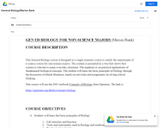
General Education Biology Course for non-science majors
- Subject:
- Biology
- Life Science
- Material Type:
- Full Course
- Provider:
- MassBay Community College
- Author:
- Marion Bank
- Date Added:
- 05/08/2019

General Education Biology Course for non-science majors

The Geniverse software is being developed as part of a five-year research project funded by the National Science Foundation. Still in its early stages, a Beta version of the software is currently being piloted in six schools throughout New England. We invite you to try the current Beta version, keeping in mind that you may encounter errors or pages that are not fully functional. If you encounter any problem, it may help to refresh or reload the web page.

This course will provide a gentle, yet intense, introduction to programming using Python for highly motivated students with little or no prior experience in programming. The course will focus on planning and organizing programs, as well as the grammar of the Python programming language.
The course is designed to help prepare students for 6.01 Introduction to EECS I. 6.01 assumes some knowledge of Python upon entering; the course material for 6.189 has been specially designed to make sure that concepts important to 6.01 are covered.
This course is offered during the Independent Activities Period (IAP), which is a special 4-week term at MIT that runs from the first week of January until the end of the month.

Business Organization and Succession Planning for Oregon Family Farms and Ranches
Short Description:
The purpose of this guide is to provide foundational education for farm and ranch families on how to create a basic business succession and estate plan. In working with farm families, we have identified four fundamental goals for the farm succession planning process: (1) preserving family relationships, (2) strengthening the farm business, (3) protecting the owners and operators from business disruptions, and (4) minimizing the complexity and expense of succession and estate plans. With some basic knowledge, you will be educated consumers of legal and financial services, which may save you time and money as you consult with the attorneys, accountants, and other professionals who are key to creating a successful plan. This guide also gives you a starting point as you consider your alternatives and begin family discussions about the roles that each family member or nonfamily member may play in the future of the farm as a business. Data dashboard Introduction summary video Chapter 1 summary video Chapter 2 summary video Chapter 3 summary video Chapter 4 summary video Chapter 5 summary video Chapter 6 summary video
Word Count: 29545
ISBN: 978-1-955101-06-6
(Note: This resource's metadata has been created automatically by reformatting and/or combining the information that the author initially provided as part of a bulk import process.)
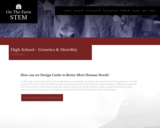
How can we Design Cattle to Better Meet Human Needs?
In this high school Storyline unit on genetics and heredity, students are introduced to ‘SuperCows’. As they explore the vast variety of cattle breeds, students discover that cattle are specialized for different purposes and while similar, the ‘SuperCows’ are clearly unique. Students wonder what caused this diversity and specificity which leads to investigations about the role of inheritance, DNA and proteins.

This module contains quiz questions( READ ONLY) and Flipped Class room activity both of which can be done by watching the videos given in author modulefollowed by these two are ppts for refernce
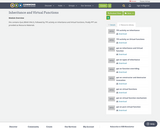
this contains Quiz (READ ONLY), Followed by TPS activity on Inheritance and Virtual Functions, Finally PPT are provided as Resource Materials
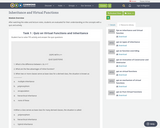
After watching the video and lecture notes, students are evaluated for their understanding on the concepts with a quiz and activity
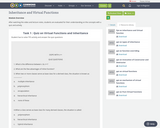
After watching the video and lecture notes, students are evaluated for their understanding on the concepts with a quiz and activity

Ever hang your head in shame after your Python program wasn't as fast as your friend's C program? Ever wish you could use objects without having to use Java? Join us for this fun introduction to C and C++! We will take you through a tour that will start with writing simple C programs, go deep into the caves of C memory manipulation, resurface with an introduction to using C++ classes, dive deeper into advanced C++ class use and the C++ Standard Template Libraries. We'll wrap up by teaching you some tricks of the trade that you may need for tech interviews.
We see this as a "C/C++ empowerment" course: we want you to come away understanding
why you would want to use C over another language (control over memory, probably for performance reasons),
why you would want to use C++ rather than C (objects), and
how to be useful in C and C++.
This course is offered during the Independent Activities Period (IAP), which is a special 4-week term at MIT that runs from the first week of January until the end of the month.

6.0001 Introduction to Computer Science and Programming in Python is intended for students with little or no programming experience. It aims to provide students with an understanding of the role computation can play in solving problems and to help students, regardless of their major, feel justifiably confident of their ability to write small programs that allow them to accomplish useful goals. The class uses the Python 3.5 programming language.

This course is an introduction to software engineering, using the Java™ programming language. It covers concepts useful to 6.005. Students will learn the fundamentals of Java. The focus is on developing high quality, working software that solves real problems.
The course is designed for students with some programming experience, but if you have none and are motivated you will do fine. Students who have taken 6.005 should not take this course. Each class is composed of one hour of lecture and one hour of assisted lab work.
This course is offered during the Independent Activities Period (IAP), which is a special 4-week term at MIT that runs from the first week of January until the end of the month.

The purpose of this casebook is to train law students to think and act like probate attorneys. This book is meant to be used in conjunction with the author's book on the law of trusts. This book's focus is problem-solving and legal application; the book includes numerous problems, so law students can learn to apply the law they learn from reading the cases. It also contains collaborative learning exercises to encourage students to engage in group problem-solving. The book is divided into three parts to reflect the main types of issues that students will encounter if they practice probate law. The book's organization mirrors the manner in which probate law is practiced in the real world.
The book starts with an examination of the intestacy system because the majority of people die without executing a will. Therefore, most of the legal issues a probate lawyer faces center around the intestacy system. Unlike the typical wills casebook, this book provides a detailed discussion of the intestacy system. A chapter on ethics is included because probate attorneys encounter ethical issues that are different from attorneys practicing in other areas of law.
The second part of the book includes an exploration of the testacy system. It is arranged so professors can lead students from the client interview to the will execution. The first three chapters of this section deal with issues that directly impact the existence of the inheritance system. It analyzes a person's ability to control the disposition of his or her property after death. This serves as the students' first introduction to the power of the “dead hand”. These chapters are included to start a public policy discussion about the rights of the dead, the right of heirs, and the necessity of an inheritance system. I tell my students that, when executing a will, they must think of the ways that it can be contested. In addition, I tell them that a will can be contested on two fronts-an attack on the testator and an attack on the will. Two chapters in this part highlight the ways that the testator's ability to execute a valid will may questioned.
The final chapters in this unit show the issues that can be raised to dispute the validity of the will. They also explain the different types of wills that are available. The final part of the book deals with non-probate transfers. These chapters are included to show students the other devises that people can use to distribute their property. That knowledge is important because the majority of people use these procedures to transfer their property. At the end of the semester, my students have to draft a will based upon a fact pattern that I give them. I intentionally include non-probate property in order to see if they will attempt to distribute that using the will.

This course provides an intensive introduction to artificial intelligence and its applications to problems of medical diagnosis, therapy selection, and monitoring and learning from databases. It meets with lectures and recitations of 6.034 Artificial Intelligence, whose material is supplemented by additional medical-specific readings in a weekly discussion session. Students are responsible for completing all homework assignments in 6.034 and for additional problems and/or papers.

Mendel was the father of genetics, but he wasn’t the final source of all information about the topic. After Mendel’s time we learned a great deal about genetics. Some of this information seemed to conflict with some of the information Mendel gleaned from his pea plants. We call this Non-Mendelian genetics. This lesson will challenge you to compare the concepts before and after Mendel and reflect on how you have inherited traits.StandardsBIO.B.2.1 Compare Mendelian and non-Mendelian patterns of inheritance.
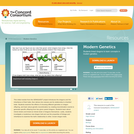
This initial module from the GENIQUEST project introduces the dragons and the inheritance of their traits, then delves into meiosis and its relationship to inherited traits. Students examine the effects of choosing different gametes on dragon offspring, and learn about genetic recombination by creating recombination events to generate specific offspring from two given parent dragons. Students learn about inbred strains and breed an inbred strain of dragons themselves.
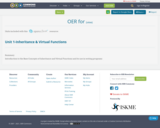
Introduction to the Base Concepts of Inheritance and Virtual Functions and its use in writing programs

Introduction to Inheritance and Virtual Functions and details of its syntax and guidance to write programs on the same

Introduction to the Base Concepts of Inheritance and Virtual Functions and its use in writing programs

Introduction to the Base Concepts of Inheritance and Virtual Functions and its use in writing programs